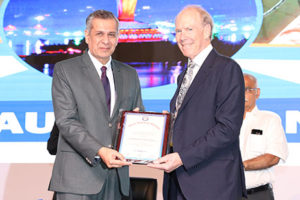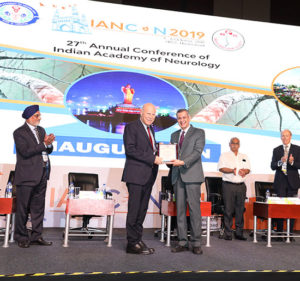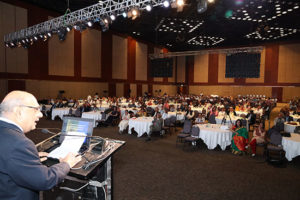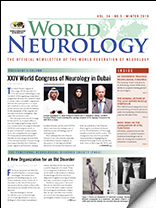A report of the 27th Annual Conference of Indian Academy of Neurology
By Gagandeep Singh, Satish Khadilkar, and Sita Jayalakshmi
The 27th Annual Conference of the Indian Academy of Neurology took place Oct. 3-6 in Hyderabad, India. The event, the most exalted professional event for the over 2,000 strong neurologists’ community in India, lasted for four days.

The Inaugural Ceremony of the 27th Annual Conference of the Indian Academy of Neurology: (From left to right) Prof. Gagandeep Singh, Secretary, Indian Academy of Neurology; Prof. Satish Khadilkar, President, Indian Academy of Neurology; Prof. Vinod Paul, Member NITI Aayog, India; Mr. Venkiah Naidu, His Excellency, Vice President of India; B Bhaskara Rao, CEO, KIMS, Hospital, Hyderabad; Prof. William Carroll, President, Worlf Federation of Neurology; Prof. Mohan Das, Chairman, Organising Committee; and Dr. Sita Jayalakshmi, Organising Secretary of the Conference.
India is a country with 1.4 billion people. This huge number is served by 2,500 neurologists, amounting to one neurologist for one million people. On the top of it all, the country is going through an unprecedented epidemiological transition commensurate with the recent strides made in the socio-economic sphere.
While neuro-infections and other neurological disorders associated with poverty and underdevelopment are only somewhat declining, there is a sweeping epidemic of non-communicable neurological disorders to confront. Subspecialty neurological practice is now in place in a few selected centers, but basic neurological care needs to be implemented in vast parts of the country. Clearly, neurologists in India have a formidable job at hand.

Prof. Satish Khadilkar, president, Indian Academy of Neurology with Prof. Carroll.
The annual conference of Indian neurologists was kicked off by Venkiah Naidu, the vice president of India, in the presence of Prof. Vinod Paul, chair of the Board of Governors, Medical Council of India and Member, National Institute for Transforming India, Prof. William Carroll, WFN president, and Prof. Wolfgang Grisold, WFN secretary general. Both the vice president and Prof. Paul emphasized the need and strategy for increasing the neurology workforce in India.

Prof. Khadilkar presenting Prof. Grisold with Honorary Membership of the Indian Academy of Neurology.
“No doubt, the number of training positions has increased from 30 in 1990 by nearly 15-fold – we now have over 450 training positions – but still we need more” said Prof. Paul. And besides, though the number of training posts have increased and there are many more neurologists than there were some 30 years ago, most of the neurologists are concentrated in a few metropolitan and larger cities of India. “We should really be having these neurologists, all equipped with computed tomography machines in the villages of India so that every individual with stroke who ought to be thrombolyzed is given his/her due” said Naidu. In his speech, Prof. Carroll outlined the philosophy of the World Federation of Neurology. In fact, he provided a roadmap for the future of neurology. Both he and Dr. Grisold agreed that the way forward was to make CT scanners and basic neurological care accessible to each village in India.

A speaker’s view of the audience.
Aside from the inaugural function, the Conference of Indian Neurologists had all of the ingredients for a successful meeting in assisting them to meet the challenges they faced. Themes and topics of over 40 symposia, quasi-workshops, continuing education programs, and hot topics varied from contemporary to futuristic, all cutting edge. Just to cite a few examples, there were symposia on artificial intelligence and continuous dopaminergic stimulation. Really, this meeting of Indian neurologists had something for everyone. There were neuroradiology rounds, grand rounds, panel discussions, a clinico-pathological conference, and even running, Yoga, and singing events for the members of the academy.
The Annual Conference of the Indian Academy of Neurology is always a glorious event, worthy of attendance by neurologists from all corners of the world. We warmly welcome neurologists form anywhere in the world to attend our future annual meetings. Just keep your eyes on www.ianindia.org for more information and updates. •
Gagandeep Singh, DM, FIAN, FICP, FAMS, FRCP, is secretary of the Indian Academy of Neurology. Satish Khadilkar, DM, FIAN, FRCP, FAMS, is president of the Indian Academy of Neurology. Sita Jayalakshmi, DM, FIAN, is organizing secretary of the 27th Annual Conference of the Indian Academy of Neurology.
